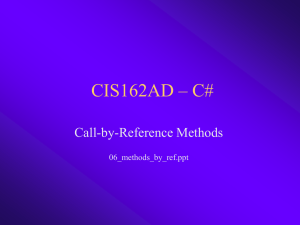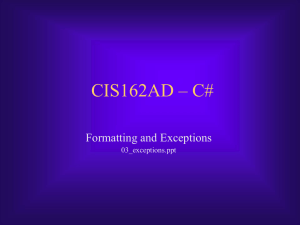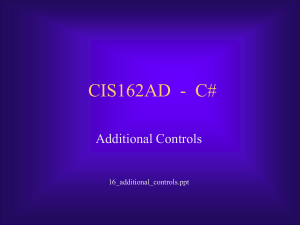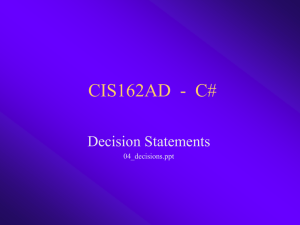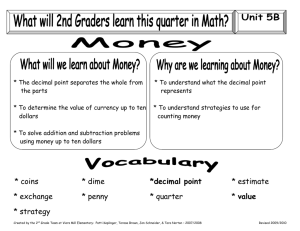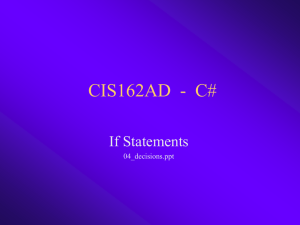decExtendedPrice
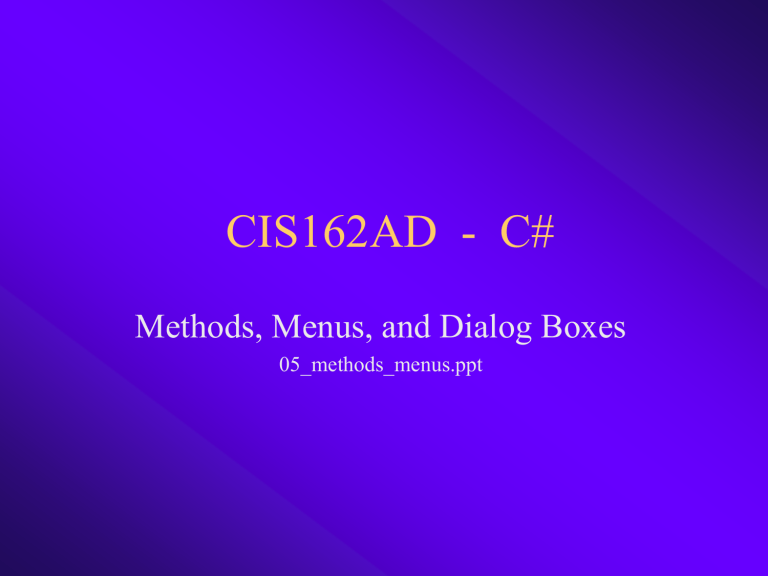
CIS162AD - C#
Methods, Menus, and Dialog Boxes
05_methods_menus.ppt
Overview of Topics
Top-Down Design
Built-in Methods
Black Box Analogy
Programmer-Defined Methods
Method’s Signature & Overloading
Pass-by-value Arguments
Menu Designer
Context Menus (right-click)
Common Dialog Boxes
CIS162AD 2
Top-Down Design
A design method where the major task to be accomplished is divided into subtasks.
– Divide-and-Conquer
– Stepwise Refinement
The goal is to write a modular program that is easier to read and maintain.
CIS162AD 3
Top-Down Design - Analogy
A design method where the major task to be accomplished is divided into subtasks.
– Major Task: clean house
– Subtasks: dust, vacuum, sweep, mop
Programming example.
– Major Task: CS5 Sales Calculator
– Subtasks: input qty, price calculate sales tax, shipping, subtotal, etc display total bill
CIS162AD 4
Subtasks
Each subtask should perform a single well-defined task.
Each subtask may produce some result.
Treat them as small programs.
Input -> Process -> Output
These subtasks can be used at different times in one program or placed in a library and used by many different programs.
The int.Parse method is a complicated task that converts strings to numbres, and is used by many different programs.
CIS162AD 5
Top-Down Design Implementation
Top-Down design is implemented using methods.
A method is a collection of statements that are grouped together to perform a specific operation.
Methods have inputs called arguments.
Methods can be defined to return no value, but if it does return a value, only one value can be returned through the return statement.
Methods can “return” more than one value through call-by-reference arguments (more on this later).
CIS162AD 6
Programmer-Defined Methods
Before coding some programmer-defined methods, let’s look at some built-in methods a little closer.
It will help understand what we are trying to develop if we look at how methods are used.
CIS162AD 7
Built-in Methods
They are like small programs.
They have their own input – process – output.
They can have one or more inputs.
But methods can only return one output.
As programmers, we don’t get to see the code
(process) of built-in methods.
The process is like a black box…
CIS162AD 8
Black Box Analogy
Many methods are designed as black boxes.
This means that as programmers we should not be concerned how the methods performs its processing.
We only need to know the inputs, outputs, and what it does.
We know what is required to use it, but we don’t know how it does its calculations.
Develop your own methods with the Black Box
Analogy in mind.
CIS162AD 9
Convert Text to Integer – int.Parse
Convert Text to Integer method is named int.Parse.
The documentation for int.Parse states the value that will be returned, method name, and the type and number of arguments. intNumber = int.Parse(String) returnedValue = MethodName (arguments)
Int.Parse takes one argument that is a String.
The method is called using the following syntax:
If txtQuantity.Text contains “3” then the function call: intNumber = int.Parse(txtQuantity.Text) would return a value of 3 into intNumber .
CIS162AD 10
Method Call
We issue a method call when we use it.
Processing control is passed to the method until it completes its task and returns control back to the calling method.
Most methods return a value back, but only one value can be returned through the return statement.
CIS162AD 11
Round Method
Methods can only return one value, but may have more than one argument.
decWholeNum = decimal.Round(decNum, 0);
The value returned is a whole number with no digits after the decimal point.
CIS162AD 12
Method’s Signature & Overloading
Method overloading occurs when more than one method with the same name is defined, but differ in the parameter list.
MessageBox.Show(TextMessage);
MessageBox.Show(TextMessage, TitleBar);
MessageBox.Show(TextMessage, TitleBar, ButtonType);
MessageBox.Show(TextMessage, TitleBar, ButtonsType, Icon);
Each method’s signature is unique and consists of:
– Method name
– The number, data types, and order of its parameters
– Parameters can also be modified with the keywords ref and out
(These keywords are covered in next powerpoint presentation)
– The signature does NOT include the data type of the returned value and the names used to identify the parameters.
CIS162AD 13
Small Programs
Think of each method as a small program with input, process, and output steps.
Output < Process < Input returnedValue = MethodName (arguments) intNumber = int.Parse(String)
CIS162AD 14
Programmer-Defined Methods
The single value that a method returns can be a string or numeric.
Two Components
1. Method Definition
2. Method Call
CIS162AD 15
Function Definition - Syntax
Syntax: private dataType MethodName(arguments)
{ statement(s) return expression;
}
dataType is where we specify what type of value is being returned, string or numeric.
Use the return statement to return the value.
Variables that will be used to store the values sent into the method are listed in parentheses as arguments.
CIS162AD 16
Method Definition - Example
private decimal calcExtendedPrice(int intQty, decimal decPrice)
{ decimal decExtendedPrice; decExtendedPrice = intQty * decPrice; return decExtendedPrice;
}
decimal is the data type of the value being returned. calcExtendedPrice is the Method Name. intQty and decPrice are the arguments passed to method.
The signature of this method is calcExtendedPrice(int, decimal)
CIS162AD 17
Return Statement
Return statement returns the value back to the variable listed to the left of the equal sign on the call statement.
Return statement returns processing control back to the calling procedure.
Only one value can be returned.
Variable data type of returned value must match the return type specified in heading.
CIS162AD 18
Multiple Returns
A method may be defined with multiple Return statements.
The first Return statement executed returns the value and returns processing control back to the calling procedure.
private decimal calcExtendedPrice(int intQty, decimal decPrice
{ if (intQty < 26) return intQty * decPrice; else return intQty * (decPrice * .95); //5% discount
}
CIS162AD 19
Single Return Preferred
Although methods can be coded using multiple Return statements, one
Return statement is preferred.
Having multiple Returns in complex procedure can be difficult to maintain and debug.
private decimal calcExtendedPrice(int intQty, decimal decPrice )
{ decimal decExtendedPrice; if (intQty < 26) decExtendedPrice = intQty * decPrice; else decExtendedPrice = intQty * (decPrice * .95); //
5% discount return decExtendedPrice;
}
CIS162AD 20
A Method without a Return
If a method that is supposed to return a value does not contain a return statement, then the compiler will generate a syntax error.
private decimal calcExtendedPrice(int intQty, decimal decPrice )
{ decimal decExtendedPrice; if (intQty < 26) decExtendedPrice = intQty * decPrice; else decExtendedPrice = intQty * (decPrice * .95);
//return decExtendedPrice; //commented out – syntax error
}
CIS162AD 21
Method Call
The method call is issued when the method is used in another method.
} private void btnCalculate_Click (…)
{ intQty = int.Parse(txtQuantity.Text); decPrice = decimal.Parse(txtPrice.Text); decExtendedPrice = calcExtendedPrice(intQty, decPrice);
CIS162AD 22
Local Variables
Variables are local to the method in which they are defined.
Variables defined in a particular method are assigned their own memory and can only be referenced in that method.
Variables defined in calcExtendedPrice( ) are assigned their own memory and can only be referenced in calcExtendedPrice( ).
Different methods cannot see or reference each others variables.
They have separate memory allocations even though the variable names may be the same.
CIS162AD 23
}
Passing Arguments
{ private void btnCalculate_Click (…) int intQty; decimal decPrice, decExtendedPrice; intQty = int.Parse(txtQuantity.Text); decPrice = decimal.Parse(txtPrice.Text); decExtendedPrice = calcExtendedPrice(intQty, decPrice); private decimal calcExtendedPrice(int intQty, decimal decPrice)
{ decimal decExtended; decExtended = intQty * decPrice; return decExtended;
}
CIS162AD 24
Declare Variables
Procedure Address btnCalculate ( ) 1010
1020
1030 calcExtendedPrice 1040
1050
1060
Variable Value intQty decPrice decExtendedPrice intQty decPrice decExtended
0
0
0
0
0
0
CIS162AD 25
Input Values
Procedure Address btnCalculate( ) 1010
1020
1030 calcExendedPrice 1040
1050
1060
Variable Value intQty decPrice decExtendedPrice
2
35.50
0 intQty decPrice decExtended
0
0
0
CIS162AD 26
decExtendedPrice = calcExtendedPrice(intQty, decPrice);
Procedure Address Variable Value btnCalculate( ) 1010
1020
1030 calcExtendedPrice 1040
1050
1060 intQty decPrice decExtendedPrice
2
35.50
0 intQty decPrice decExtended
2
35.50
0
Pass-by-Value - Values in variables of btnCalculate are sent to variables of calcExtendedPrice.
CIS162AD 27
}
Methods Use Local Variables
private void btnCalculate_Click (…)
{ int intQty; decimal decPrice, decExtendedPrice; intQty = int.Parse(txtQuantity.Text); decPrice = decimal.Parse(txtPrice.Text); decExtendedPrice = calcExtendedPrice(intQty, decPrice); private decimal calcExtendedPrice(int intQty, decimal decPrice)
{ decimal decExtended;
}
CIS162AD decExtended = intQty * decPrice; return decExtended;
28
decExtended = intQty * decPrice;
Procedure Address btnCalculate( ) 1010
1020
1030 calcExtendedPrice 1040
1050
1060
Variable Value intQty decPrice decExtendedPrice intQty decPrice decExtended
2
35.50
0
2
35.50
71.00
CIS162AD 29
Returning Method Values
}
{ private void btnCalculate_Click (…) int intQty; decimal decPrice, decExtendedPrice; intQty = int.Parse(txtQuantity.Text); decPrice = decimal.Parse(txtPrice.Text); decExtendedPrice = calcExtendedPrice(intQty, decPrice); private decimal calcExtendedPrice(int intQty, decimal decPrice)
{ decimal decExtended; decExtended = intQty * decPrice; return decExtended;
}
CIS162AD 30
decExtendedPrice = calcExtendedPrice(intQty, decPrice)
Procedure Address btnCalculate( ) 1010
1020
1030 calcExtendedPrice 1040
1050
1060
Variable intQty decPrice decExtendedPrice
Value
2
35.50
71.00
intQty decPrice decExtended
2
35.50
71.00
Return statements sends the value to variable on the left side of the equal sign on the method call statement.
CIS162AD 31
Menu Designer
Plan menu options / paths.
Add MenuStrip control to component tray.
Just like the ToolTip.
Enter Text for menu item in box labeled Type Here .
Use ampersands to define control keys.
Name menu items using menu path and mnu prefix.
Need to know name so we can tell which menu item was selected in the code.
private void mnuFileExit_Click(object sender, System.EventArgs e)
{ this.Close();
}
CIS162AD 32
CIS162AD
Menu Designer Example
33
Context Menus
Context menus are shortcut menus that pop up with a right-click.
Add a ContextMenuStrip control to the component tray.
Use the Menu Designer to add items.
More than one context menu can be added.
In order to make the context menu available to users, it must be assigned to the form or control by using the
ContextMenuStrip property.
See the images on the next two slides…
CIS162AD 34
CIS162AD
Context Menu Example
35
CIS162AD
Assign Context Menu to Form
36
Common Dialog Boxes
Common dialog boxes available:
– FontDialog
– ColorDialog
– OpenFileDialog
– SaveFileDialog
– PrintDialog
– PrintPreviewDialog
CIS162AD 37
Common Dialog Boxes
The Common Dialog Box controls can save programmers the time and trouble of designing custom dialog boxes for common purposes.
Add a common dialog box control to the component tray.
The default Name of the Dialog maybe used, unless more than one is being used in the program..
colorDialog1, fontDialog, etc.
You won’t see anything in design time, because the dialog box is displayed at run-time with code.
Use the ShowDialog method to display a dialog box.
fontDialog1.ShowDialog( ); colorDialog1.ShowDialog( );
CIS162AD 38
CIS162AD
FontDialog Box
39
Using Selected Options
Dialog Boxes are objects themselves with properties.
The values selected by users in a font or color dialog box are stored in the dialog box’s properties.
The values in the dialog boxes selected by users need to be applied to controls on the form.
lblGrandTotal.Font = fontDialog1.Font; lblGrandTotalForeColor = colorDialog1.Color;
Note: property on Labels and Textboxes is ForeColor.
Before showing a dialog box, you should assign to it the current value selected just incase users click on Cancel.
CIS162AD fontDialog1.Font = lblGrandTotal.Font;
40
Method Example
private void mnuEditFont_Click(object sender, System.EventArgs e)
{
//Initialize the font in the dialog box to the current font fontDialog1.Font = lblGrandTotal.Font;
//Display dialog box so user can pick a font fontDialog1.ShowDialog();
//Apply the font chosen to the Totals section lblGrandTotal.Font = fontDialog1.Font; lblNumberOfOrders.Font = fontDialog1.Font; lblAverageOrder.Font = fontDialog1.Font;
}
CIS162AD 41
Summary
Top-Down Design
Built-in Methods
Black Box Analogy
Programmer-Defined Methods
Method’s Signature & Overloading
Menu Designer
Context Menus
Common Dialog Boxes
CIS162AD 42
